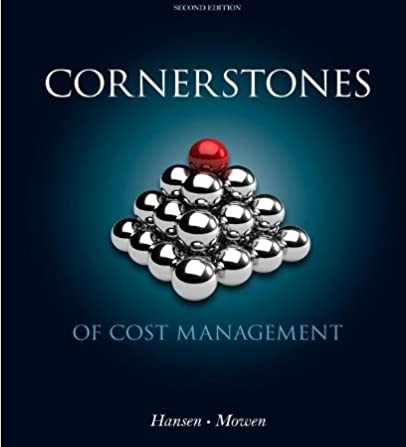
Cornerstones of Cost Management 2nd Edition by Don Hansen ,Maryanne Mowen
Edition 2ISBN: 978-1111824402
Cornerstones of Cost Management 2nd Edition by Don Hansen ,Maryanne Mowen
Edition 2ISBN: 978-1111824402 Exercise 41
Appendix: Normal and Abnormal Spoilage
Larkin Company produces leather strips for western belts using three processes: cutting, design and coloring, and punching. The weighted average method is used for all three departments. The following information pertains to the Design and Coloring Department for the month of June:
a. There was no beginning work in process.
b. There were 400,000 units transferred in from the Cutting Department.
c. Ending work in process, June 30: 50,000 strips, 80 percent complete with respect to conversion costs.
d. Units completed and transferred out: 330,000 strips. The following costs were added during the month:

e. Direct materials are added at the beginning of the process.
f. Inspection takes place at the end of the process. All spoilage is considered normal.
Required:
1. Calculate equivalent units of production for transferred-in materials, direct materials added, and conversion costs.
2. Calculate unit costs for the three categories of Requirement 1.
3. What is the total cost of units transferred out? What is the cost of ending work-in-process inventory? How is the cost of spoilage treated?
4. Assume that all spoilage is considered abnormal. Now, how is spoilage treated? Give the journal entry to account for the cost of the spoiled units. Some companies view all spoilage as abnormal. Explain why.
5. Assume that 80 percent of the units spoiled are abnormal and 20 percent are normal spoilage. Show the spoilage treatment for this scenario.
Larkin Company produces leather strips for western belts using three processes: cutting, design and coloring, and punching. The weighted average method is used for all three departments. The following information pertains to the Design and Coloring Department for the month of June:
a. There was no beginning work in process.
b. There were 400,000 units transferred in from the Cutting Department.
c. Ending work in process, June 30: 50,000 strips, 80 percent complete with respect to conversion costs.
d. Units completed and transferred out: 330,000 strips. The following costs were added during the month:

e. Direct materials are added at the beginning of the process.
f. Inspection takes place at the end of the process. All spoilage is considered normal.
Required:
1. Calculate equivalent units of production for transferred-in materials, direct materials added, and conversion costs.
2. Calculate unit costs for the three categories of Requirement 1.
3. What is the total cost of units transferred out? What is the cost of ending work-in-process inventory? How is the cost of spoilage treated?
4. Assume that all spoilage is considered abnormal. Now, how is spoilage treated? Give the journal entry to account for the cost of the spoiled units. Some companies view all spoilage as abnormal. Explain why.
5. Assume that 80 percent of the units spoiled are abnormal and 20 percent are normal spoilage. Show the spoilage treatment for this scenario.
Explanation
1.Equivalent units are computed as under...
Cornerstones of Cost Management 2nd Edition by Don Hansen ,Maryanne Mowen
Why don’t you like this exercise?
Other Minimum 8 character and maximum 255 character
Character 255


